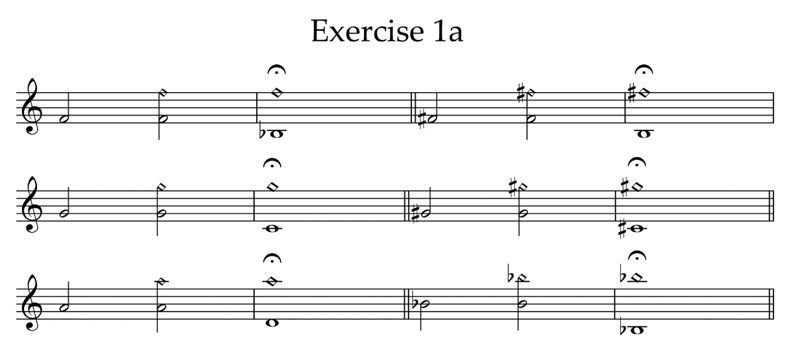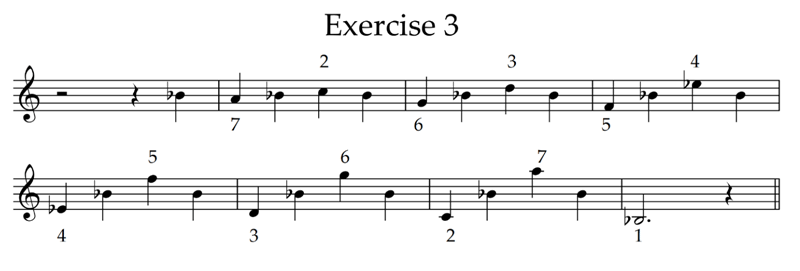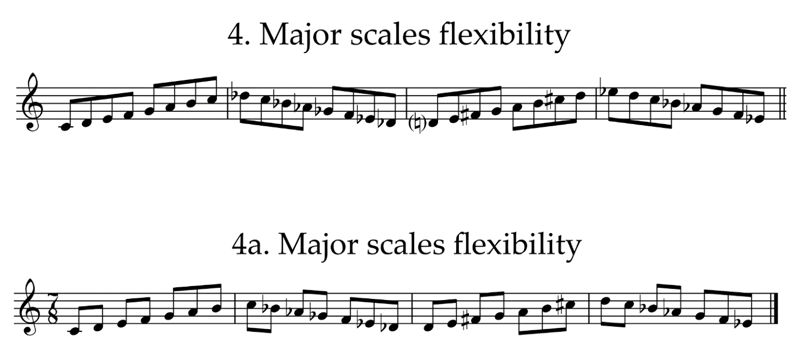4 Powerful Exercises for Saxophone Sound and Flexibility

Powerful In this article, I share some exercises for solidifying the most important fixtures of my practice routine – sound and flexibility.
Exercise #1: Opening Up Your Sound
I think of this exercise as a way of working towards a bigger sound by making sure that the flow of air is not constricted as it moves through the throat.
Important points to keep in mind…
- Since this one is chromatic, you don’t have to make big interval jumps. Focus on how you can best get an open and free sound by gradually moving upwards in register in a smooth and “legato” manner.
- Remember to support the tone and airflow with the body as you play
- If you’re not familiar with concept of overtones (which are what this exercise is based around), keep in mind that bottom notes are the fingerings while top notes represent the pitches you’re actually producing.
- It should be played both up and down.
Below is the exercise written across two octaves, but feel free to go higher if you’d like to further develop your skill in the altissimo register.
Remember to play it slowly to begin with and work your way up in tempo.

Taking the exercise a bit further with Exercise 1a below…
We can now use bigger intervals and focus on the conscious awareness of the air as it moves through the throat.
Important points to keep in mind…
- You make the octave shift without using the octave key – solely by manipulating the position of the muscles inside the of the throat as well as maximizing the airflow.
- It might help to think of different vowels of the alphabet (A, E, I, O, U) – going from, for instance, the “AH” vowel sound on the first note, the “EE’ vowel sound on the 2nd octave F, etc.
- You are not supposed to sing the vowels out loud – only to manipulate the muscles inside the throat as though you are singing.
- Maintain the feeling of your selected vowel sound when alternating between fingerings.
- It might also help to imagine an “elevator” in your throat moving up and down very smoothly, combined with the shaping of the vowels.
- You can repeat each 2 bar exercise several times and also alternate repeatedly between the fundamental (the 1st note in the staff) and the overtone.
Once again, the bottom notes are the fingerings while top notes are the notes that you hear actually coming out of the instrument.

Like the previous exercise, this exercise can also be expanded going further upwards, and both of the previous two exercises can of course be supplemented with other overtone exercises that you like to warm up with.
#2: Diatonic steps – 1
This exercise also aims to open up your sound using intervals within the major scale.
Important points to keep in mind…
- This exercise can be played in all 12 keys and in different registers.
- The focus is still on smoothness, an open sound, and legato playing.
- Again, it might help to think of different vowels of the alphabet – going from for instance the ‘AH” vowel on the first note (low Bb) to the darker vowel “O” on the lower notes.

#3 Diatonic steps – 2
This one is a more advanced version of Exercise 2, now expanding the intervals.
Important points to keep in mind…
- It can be played in all 12 keys and in different registers.
- The added numbers indicate the degree within the scale.
- Here again, you can experiment with the use of shaping vowels in the throat – a bright vowel (“EE”) on the top notes and a dark vowel (“I”) on the low ones to support a smooth change in register.

#4 Flexibility from key to key
After working on the previous exercises for opening your sound, I move on to this exercise which focuses on agility and flexibility in moving smoothly from one key to another.
Important points to keep in mind…
- The exercise below centers on major scales but can be applied to any scales (natural minor, harmonic minor, diminished, half diminished, etc.).
- It should be played both up and down through the entire register of the saxophone, so you run through all 12 keys.
- Where exercise 4 is in 4/4 time and puts you on the root of the scale on beat 1, 4a is written in 7/8, forcing you to begin the next key starting on the 7th degree of that scale.
- As with all of the exercises, start at a slow tempo and speed up gradually. The important thing is to focus on smoothness from the very beginning to develop both brain and muscle memory. There’s no need to rush!

Conclusion
These are just a few of ideas for warming up your sound, technique, and flexibility.
To me, each little exercise always can be adapted for different scales, rhythms, and registers, to name just a few parameters you can use to take your playing to the next level.
I do hope that these ideas turn out to be useful in moving you forward in your journey playing this incredible instrument!
Pernille Bévort’s Saxophone Setup
- Tenor saxophone: Selmer M6 from 1962 with a Morgan New York n.7 mouthpiece (rubber)
- Reeds on tenor: D’Addario, Select Jazz, Filed, 3 soft
- Soprano saxophone: Selmer Series III – Selmer Mouthpiece E from the 80’s (rubber)
- Reeds on soprano: Vandoren Blue 2,5
- Both with Marc Jean Ligatures especially made for Morgan.
For more of Pernille’s work, check out the following links.
www.pbevort.dk
https://www.facebook.com/pernillebevortmusic
https://open.spotify.com/playlist/19nXbQ0h3d66sGZOeGH4cR?si=d86550272d42495b






April 2, 2024 @ 3:10 pm
Wow! I was just practicing something like this yesterday off the top of my head, ty